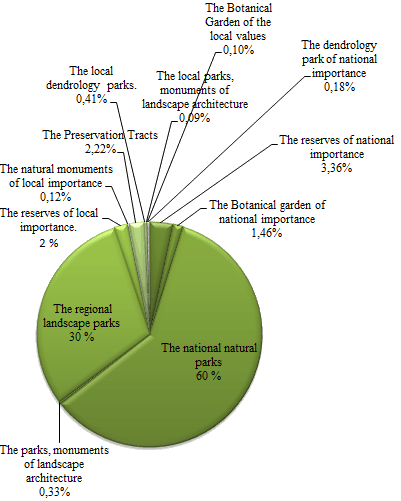Abstract
TABLE OF CONTENTS
- Introduction
- 1. Objectives, principles and methods of forming ecological networks
- 2. Physico-geographical and socio-economical characteristics of the Kharkiv region in terms of formation of the ecological network
- 3. General characteristics of the structure of the natural–reserve fund of the Kharkiv region
- Conclusion
- References
Introduction
Actual of this work – ecological networks is the most effective form of conservation of landscape and biological diversity for the regions and countries where the wildlife is very different from the natural habitat.
Ecological meaning of this situation consist in the fact that natural areas are converted by human activity, therefore, the areas lost their spatial relationship to each other. They inevitably lost their biological diversity because of the inability of genetic and biogeochemical exchanges among themselves, and gradually merge with the environment.
Novelty – the first time provides a critical analysis of promising schemes of the regional ecological network of the Kharkiv region.
Objective: to conduct a comprehensive assessment of the composition and spatial structure of Kharkiv REN.
Research of objectives:
- to study the background, objectives and principles of ecological networks;
- to assess the natural and socio-economic conditions of the REN of the Kharkiv region;
- to provide a comprehensive assessment of the structure of the Kharkiv region of NRF as a basic element of its REN[1].
The such works were executed by the students of DonNTU, a leader of which is an associate professor Andrey Alfredovich Blakbern. For example, master's degree work of Yu.I. Kornelyuk on a theme Investigation of possibilities of forming a regional ecological network of Lugansk region
, Yu.A. Gukovoy – Investigation possibilities of forming of lokal ecological networks on territory of Donetsk region
and others.
1 Objectives, principles and methods of forming ecological networks
In 1995 it was drafted and adopted the document Strategy for Pan-European Biological and Landscape Diversity
(PES) at the Sofia Ministerial Conference on the Environment of the European states with the leadership of the Council of Europe and the United Nations Economic Commission for Europe. PES is the first attempt to coordinate environmental activities throughout the Pan-European area, from the Azores to the Kuril Islands. The main objective of the Strategy – to halt and reverse the process of destruction of natural ecosystems, to preserve the European landscapes, and plant and animals. The strategy involves a holistic approach to solving this problem, taking into account social and economic factors.
The development of a system of priorities for investment in conservation is an important component of the PES. PES is designed for realize during 20 years (1995-2015). The strategy lays the foundation for uniting the efforts of European states to implement the provisions of the Convention on Biological Diversity and other international conventions and agreements.
2 Physico-geographical and socio-economical characteristics of the Kharkiv region in terms of formation of the ecological network
The Kharkiv Region is one of the largest regions of Ukraine on the territory, population and development of the national economic complex. It’s a large industrial center of Ukraine, which represents almost all economic activities.The area bordere on the most industrialized Donetsk, Luhansk and Dnipropetrovsk regions, and with the Russian Federation on the north–east of the country. All of this is due to environmental concerns in the region (fig. 1).
In the north Kharkov is bordered on Belgorod region of Russia, in the east – Lugansk region, in the south-east – Donetsk, in the south – Dnepropetrovsk, in the west – Poltava and the north-west – Summ region of Ukraine. The region is a border territory. The area of the Kharkiv region is 31,420 кm2, representing 5.2% of the territory of Ukraine, the distance from east to west – 225 km, from north to south – 210 km. For this indicator, the region occupies the 4th place in the country after Odessa, Dnipropetrovsk and Chernihiv regions [2].
Relief is the undulating plain, which is demarcated by river valleys, ravines and gullies. The region is confined to the basins of the rivers Don and Dnieper. Don basin accounts for 75% of the region, the Dnieper River basin – 25%.The climate of the Kharkiv region is moderate continental. It is formed by the interaction of three main factors: solar radiation, atmospheric circulation and the nature of the underlying surface. Since the length of the region from west to east elevation is small and fluctuations are small too, the variation in climate of the area is not important. The fluctuations in annual mean temperature is 21°C in summer and -7°C in winter. June is the warmest month, January – the coldest. The amplitude of the monthly average temperature is 28°C. Average annual rainfall is about 540 mm.
27 administrative districts, 17 cities, including 7 of regional significance (Kharkov, Raisins, Kupyansk, Lozova, Lyubotin, Pervomaisky Chuguev), 61 urban-type settlements, 381 village councils, 1,682 rural settlements included in the the Kharkiv region. The advantageous geographical location and natural–resource potential are the features of social and economic development.
On January 1, 2010 population of Kharkiv region is 2,769,1 million, of which 79.96 % are urban and 20.04 % are rural population. The region occupies the 4th place in Ukraine, second only to the Donetsk and Dnipropetrovsk oblasts and Kyiv by the population.
The Kharkov region has extremely low water availability and occupies 24th place among the Ukrainian regions on this indicator (1.8 % of total water resources of Ukraine, taking into account the flow of adjacent areas). The Kharkov region is situated on the watershed of two river basins of the Don (Northern Donets), and the Dnieper. 17 administrative regions belong to the basin of the Seversky Donets, and 10 – to the area of the Dnieper.

Figure 1 – Zmiivska warmth electric power station
3 General characteristics of the structure of the natural-reserve fund of the Kharkiv region
Natural areas and sites of the NRF of the region are the national natural parks, the regional landscape parks, the gardens and sleek, the zoological parks, the sanctuaries of national and local significance, the natural monuments and protected tracts of local importance [3].
On 1 January 2011 natural – reserve fund area has 238 sites and facilities (the area is 72,699.21 hectares), including 13 sites of national importance (the area is23,984.6 hectares). It is 2.3 percent of nature protection of the total area of the region (fig. 3). In 2010 useing of natural resources and economic activities within the territories and objects of the nature-reserve fund of the Kharkiv region were carried out in accordance with the plans of the sanitary and health measures.
The area of the landscape reserve of local importance Pecheneg
(area is 365.7 hectares) is the part of the regional landscape park Pechenezhskoe field
.
The territory of the general zoological reserve of national importance Katerinovsky
(area is 527.0 hectares), the general zoological reserve Burlutskiy
(area is 326.0 hectares), the reserve tract Bozhkova
(area is 79.0 hectares) and parts of the reserve tract Dyagternoe
(area is 95.0 hectares) included in the regional landscape park Velikoburluksky steppe
(fig. 2). Part of the landscape reserve Gomolshanskaya timber cottage
(area is 8355.0 hectares) is part of the National Park Gomolshanskie forest
. Forest local reserve Vladimir giving
(area is 699.0 hectares) is part of the National Park Slobozhanskiy
.

Figure 2 – The regional landscape park Velekoburluzkiy step
The botanical reserves of local importance Hemp
(area is 315.9 hectares) and the Red
( area is 49.8 hectares) included in the National Park Dvurechansky
. The territory of the botanical reserve of local importance Borovsky
(area is 18.0 hectares) is part of the regional landscape park Krasnooskolskoe
. [4].
The current state of biodiversity of the region is restless and that’s why it requires a detailed analysis of its phytocentral and habitat distribution, especially rare species, because assessment of faunal and floral wealth depend on the presence of rare species (fig. 4).

Figure 3 – The total area of the Kharkiv region of NRF (in shares)
Analysis of the distribution diagram of categories of objects of NRF of the Kharkiv region (in share) showed that the national parks occupied 60 % of the land area of NRF’s area, 30 % – regional landscape parks, 3.36 % – reserves of national importance, 2.22 % – reservation tracts, 2 % – local nature reserves, 1.46 % – national botanical garden 0.41 % – the local dendrology park, 0.33 % – the parks, memorials of landscape art of national importance, 0.18 % – the national dendrology park, 0.12 % – the natural monuments of local importance, 0.10 % – the local botanical garden, 0.09 % – the parks, memorials of landscape art of local importance.

Figure 4 – Species diversity of categories of objects NRF of the Kharkiv region
With regard to biodiversity in the region (fig. 4), we can say that the national parks are the richest objects in the number of species of plants and animals. There are 13 rare and endangered species of plant and 6 species, which are making in the European list, and 4 species of red-plants and 5 – animals [4].
Thus, the indicator is the species that are critically threatened with extinction. There are many such species of plants and animals in the national parks. Important in terms of conservation and habitat diversity phytocentral, is that it does not matter what area of the object of NRF, and how many rare and endangered plants and animals they can keep in pristine condition.
Conclusion
Result of this work is next:
- In 1995 Pan-European strategy was adopted, which involves a single approach to the region to preserve biological and landscape diversity taking into account social and economic factors.
- The Kharkov region has a favorable geographical and economic position, because it connects the Russian Federation with the countries of Central and Eastern Europe, it’s the strategic highway pass through the territory of the region; it’s the main hub for rail in eastern Ukraine, it attended by six related areas; it has an international airport that receives passenger aircraft of all types.
- NRF has 238 sites and facilities (the area is 72,699.21 hectares), including 13 sites of national importance (the area is23,984.6 hectares). It is 2.3 percent of nature protection of the total area of the region. The national parks occupy first place in number of the rare and endangered plants and animals in the average area of objects NRF of the region. Important in terms of conservation and habitat diversity phytocentral, is that it does not matter what area of the object of NRF, and how many rare and endangered plants and animals they can keep in pristine condition.
Ecological Network of the Kharkiv region is the part of the National Ecological Network of Ukraine, which connects it to the National Environmental Network of Russian Federation in single European ecological network.
References
- Биологического и ландшафтного разнообразия, Панъевропейская (общеевропейская) стратегия [Электронный ресурс] – Режим доступа: http://vasilievaa.narod.ru/mu/csipfo/kpr/frames/guide/biodivereuropestrat.htm
- Алексеенко М.И. Растительность Харьковской области. Природа и хазяйство/ М.И. Алексеенко. – Х.: Харьк. ун-та, 1971. – 80–94 с.
- Гродзинський Д.М., Шеля-Сосонко Ю.Р., Черевченко Т.М. Проблеми збереження та відновлення біорізноманіття в Україні/ Д.М. Гродзинський, Ю.Р. Шеляг-Сосонко, Т.М. Черевченко. – К.: Академперіодика, 2001. – 104 с.
- Вовк О.Г., Філатова О.В., Тверетінова В.В. Види флори Харківщини, що підлягають охороні/ О.Г. Вовк, О.В. Філатова, В.В. Тверетынова. – Рідний край. – 2-е вид. Харків: ХДПУ, 1999. – С. – 24-34.
